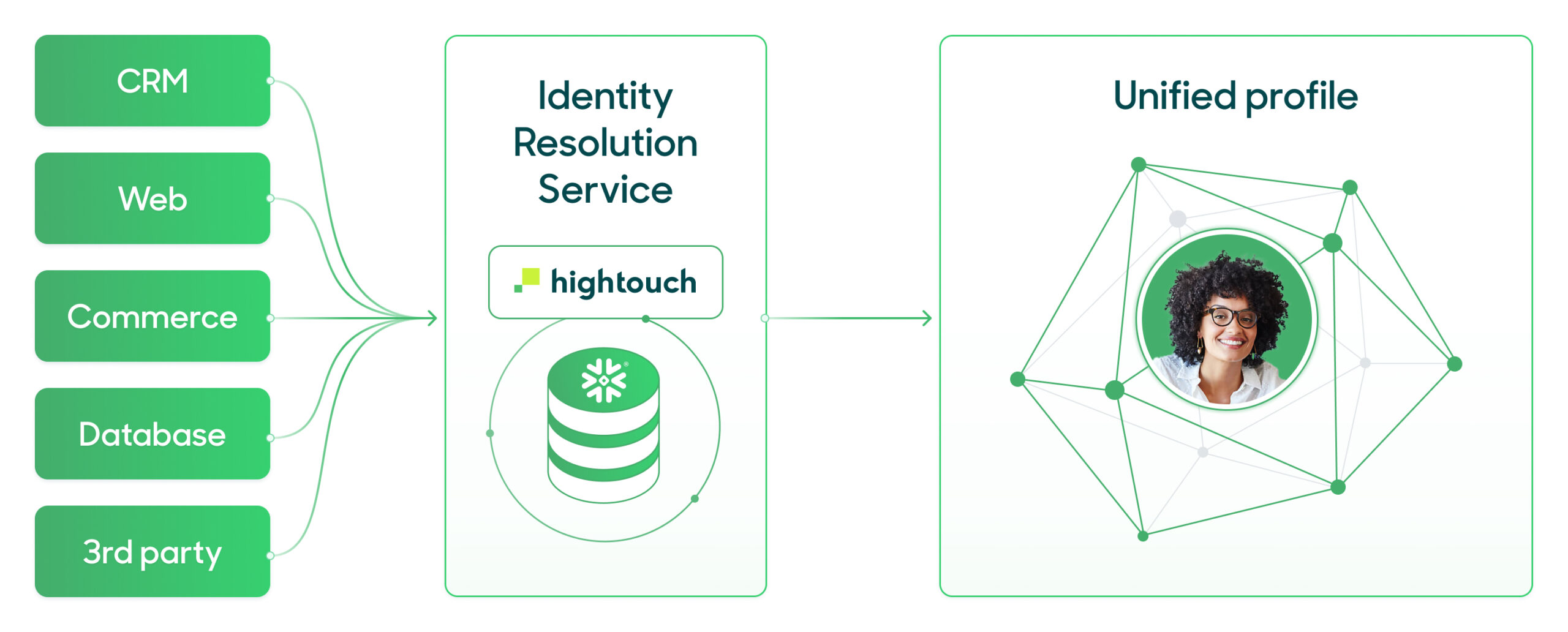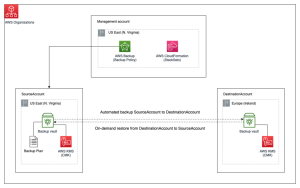
Resolving and deduplicating customer identity is a fundamental challenge faced by every data team that supports marketing and business teams. Without the ability to accurately identify individuals within the vast sea of data, delivering reliable dashboards and activating data to understand and influence customer behavior becomes nearly impossible. Shockingly, a Gartner Marketing survey revealed that only 14% of companies have a 360-degree view of customers, which means the majority of organizations are grappling with the management of fragmented and incomplete customer data.
To address these challenges head-on, Snowflake and Hightouch worked together to build an Identity Resolution feature that runs directly in the Data Cloud. This powerful integration allows Snowflake users to seamlessly stitch together customer data collected from across their business, creating rich and comprehensive customer profiles within the well-governed environment of the Data Cloud.
Let’s take a closer look at why identity resolution matters and how integrating identity resolution via Hightouch and Snowflake helps organizations deliver accurate analytics, personalized experiences, and data-driven growth.
The case for identity resolution
Identity resolution is the process of stitching together user actions and attributes to create a unified customer profile. Doing so enables businesses to transcend the limitations of fragmented data sources and gain deep insights into individual customer behavior.

Previously, to achieve these single customer profiles, businesses had to either rely on internal resources to model the data themselves or implement a customer data platform (CDP) that required the data to leave the environment and be stored in yet another system. Additionally, these rigid, external CDP identity resolution solutions did not fully incorporate all of the customer data available to organizations within the Data Cloud.
With Hightouch’s Identity Resolution running natively in the Snowflake Data Cloud, there is no need for information to leave the organization’s secure infrastructure—reducing risks and eliminating the need for lengthy software implementations.
Imagine effortlessly connecting every customer data point and interaction, regardless of the device used, channel engaged, or time of occurrence. This comprehensive view of each customer, achieved through identity resolution, is readily accessible within the Data Cloud, empowering business teams to deliver highly personalized experiences, make informed decisions, and drive meaningful engagement at every touchpoint.

How Hightouch Identity Resolution in the Data Cloud works
The new Hightouch Identity Resolution feature enables organizations with a powerful no-code UI to define logic to create unified customer profiles and then associate events with those profiles. Hightouch simply reads from existing data sets and creates an identity table in the organization’s Snowflake instance, where it is then available to power downstream use cases. Organizations can set recurring schedules for their identity resolution projects within Hightouch, and monitor performance and outcomes at a glance.

Data onboarding: Organizations can access different profile and event tables directly from Snowflake in Hightouch, and define the key identifiers that should be used from each table. Hightouch also enables organizations to define custom models in their Snowflake data with SQL or dbt—whatever data exists in the Snowflake Data Cloud is available for identity resolution.

Merge rules: Users can add multiple layers of boolean logic and define the specific match types (such as exact vs. fuzzy) and identifier standardization (such as remove whitespace), giving them flexibility to customize exactly how identifiers should merge.

Blocking and conflict resolution: Organizations can define the maximum number of identifiers they would allow per profile. When the profile exceeds these limits, joins are flagged as conflicts, which are resolved by conflict resolution logic that the organization defined in advance.

Output: Finally, Hightouch writes the results of this unification—an Identity Graph—directly to a table within the organization’s Snowflake instance. The organization is now fully equipped to take action on its unified customer data.
Transforming use cases with identity resolution
Now that you have your unified customer profiles, what can you do with them? Here are a few examples.
Audience building
Audience building is pivotal in effective marketing strategies. With the ability to access a wide range of data points—such as purchase history, browsing behavior, or demographic information—on customer profiles stored within the Data Cloud, business users can use Hightouch Customer Studio to create highly targeted audience segments. These segments can then be sent to over 200 destinations such as CRMs and ad platforms, where they are dynamically updated in near real time, ensuring that marketing campaigns are always tailored and up-to-date. This empowers marketers to build their audiences by delivering personalized messaging and offers across multiple channels, resulting in improved customer engagement, higher conversion rates, and increased ROI.

Customer analysis
Organizations gain a holistic view of customer interactions, preferences, and purchase journeys by integrating all relevant customer data into unified profiles in the Data Cloud. Then, teams can use Hightouch’s powerful analytics features to extract valuable insights and perform advanced analysis on the now-unified customer data with ease.
Business users can uncover patterns, trends, and correlations previously hidden in fragmented customer profiles. They can identify high-value customer segments, analyze customer lifetime value, and understand the impact of specific marketing campaigns to help inform and continuously optimize their audience strategies.

Third-party data onboarding
In addition to leveraging first-party data, businesses often benefit from enriching their customer profiles with external data sources. The new Identity Resolution feature simplifies the process of onboarding and integrating third-party data by quickly enabling teams to resolve their third-party data sets directly in the Data Cloud.
Doing so enables businesses to merge their first-party data with external data sets, such as demographic information. ZoomInfo, Affinity Solutions, Similarweb, and SafeGraph are all popular options available in Snowflake Marketplace, along with many more. This enriched customer data enhances the accuracy and depth of customer profiles, enabling more precise targeting and personalization.
Entity resolution
Hightouch’s Identity Resolution feature is flexible enough to configure for any business use case. Organizations can define which profiles they want to merge and how they want to merge them. Most organizations are interested in profile resolution for individual customer identities, but Hightouch and Snowflake also empower other entity resolution use cases.
For example, a cable company’s primary interest isn’t in selling to individual people; instead, the company is selling its services at the household level. A cable company could unify all household-level data in their Snowflake instance using Hightouch’s Identity Resolution feature, just as easily as unifying individual customer profiles. Similarly, a B2B organization could unify account, client, or business entities in the Data Cloud with the new feature.

Summary
Regardless of their data maturity, businesses can now leverage the power and flexibility of their existing data infrastructure to create accurate and reliable customer profiles. The combination of the robust Snowflake Data Cloud and Hightouch’s innovative solutions empowers marketers and data teams alike to maximize the value of their data, achieve superior customer insights, and deliver exceptional customer experiences in the digital age.
Want to learn more? Read this brief to discover how leading organizations leverage Hightouch and the Snowflake Data Cloud to create a marketing and personalization engine.


